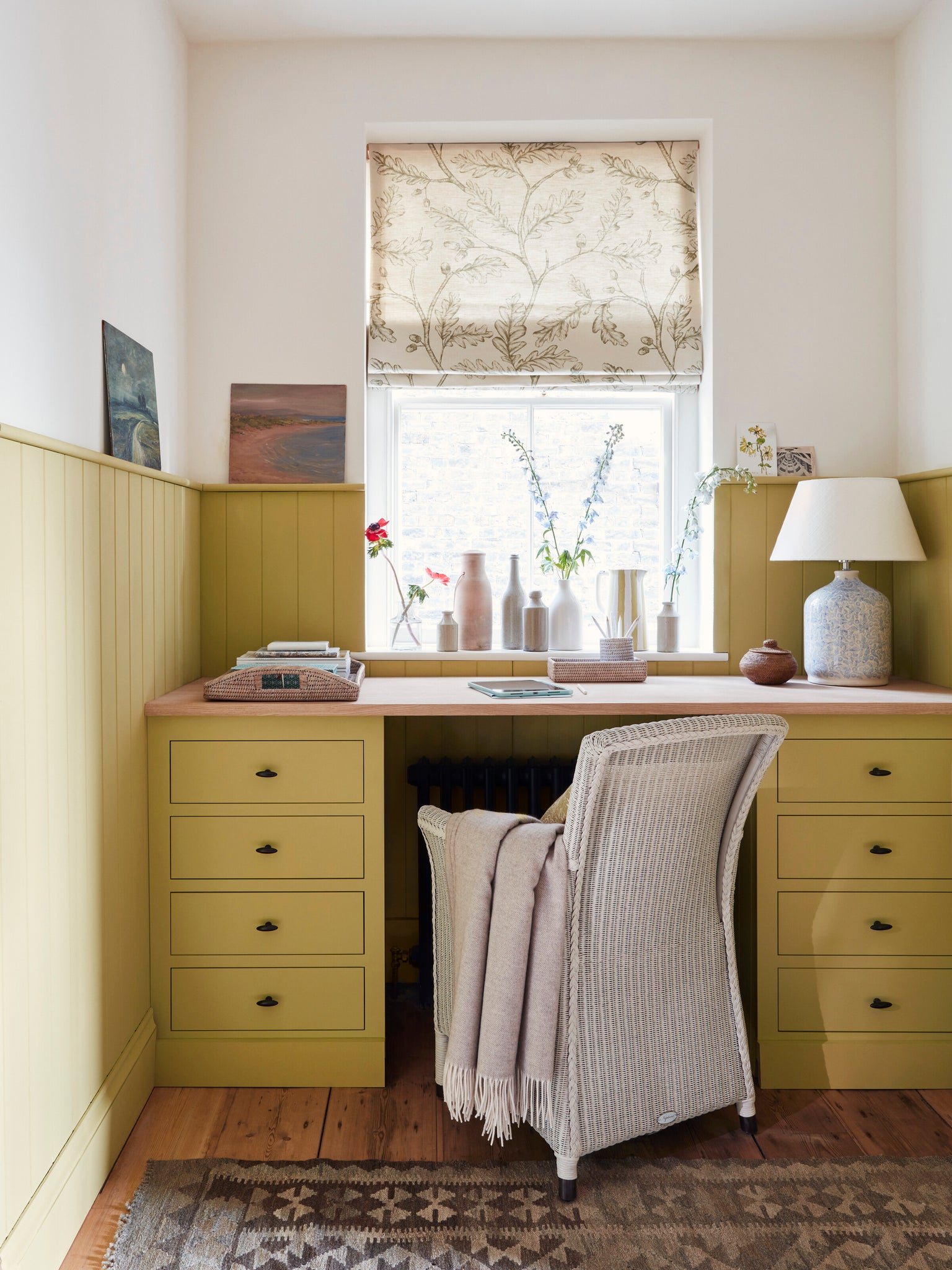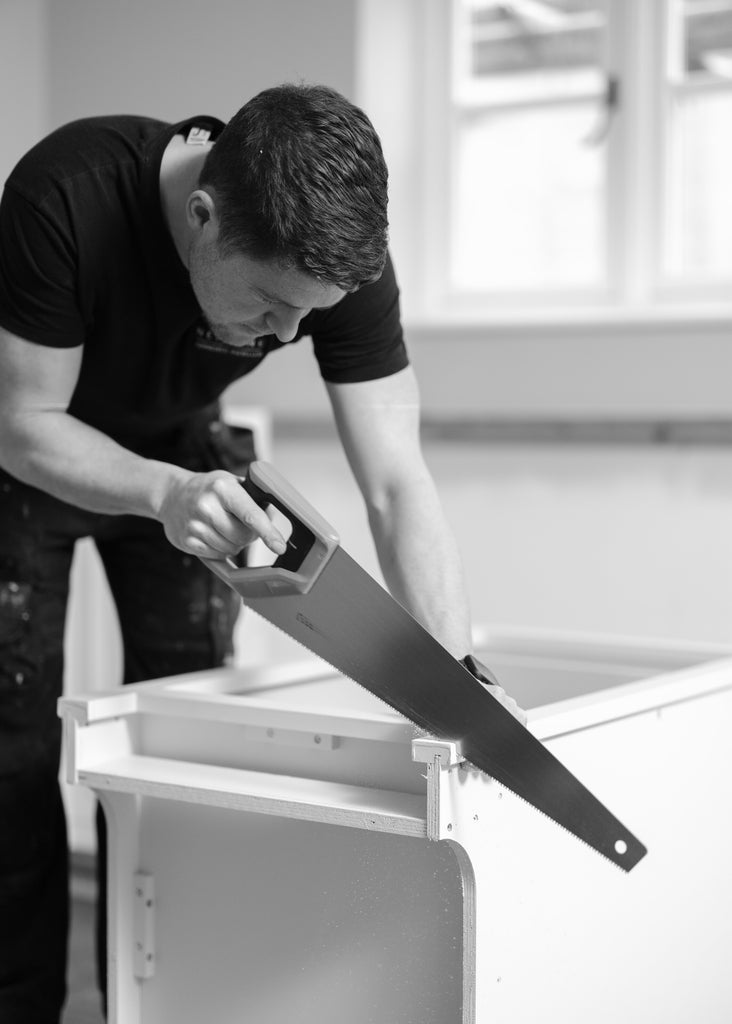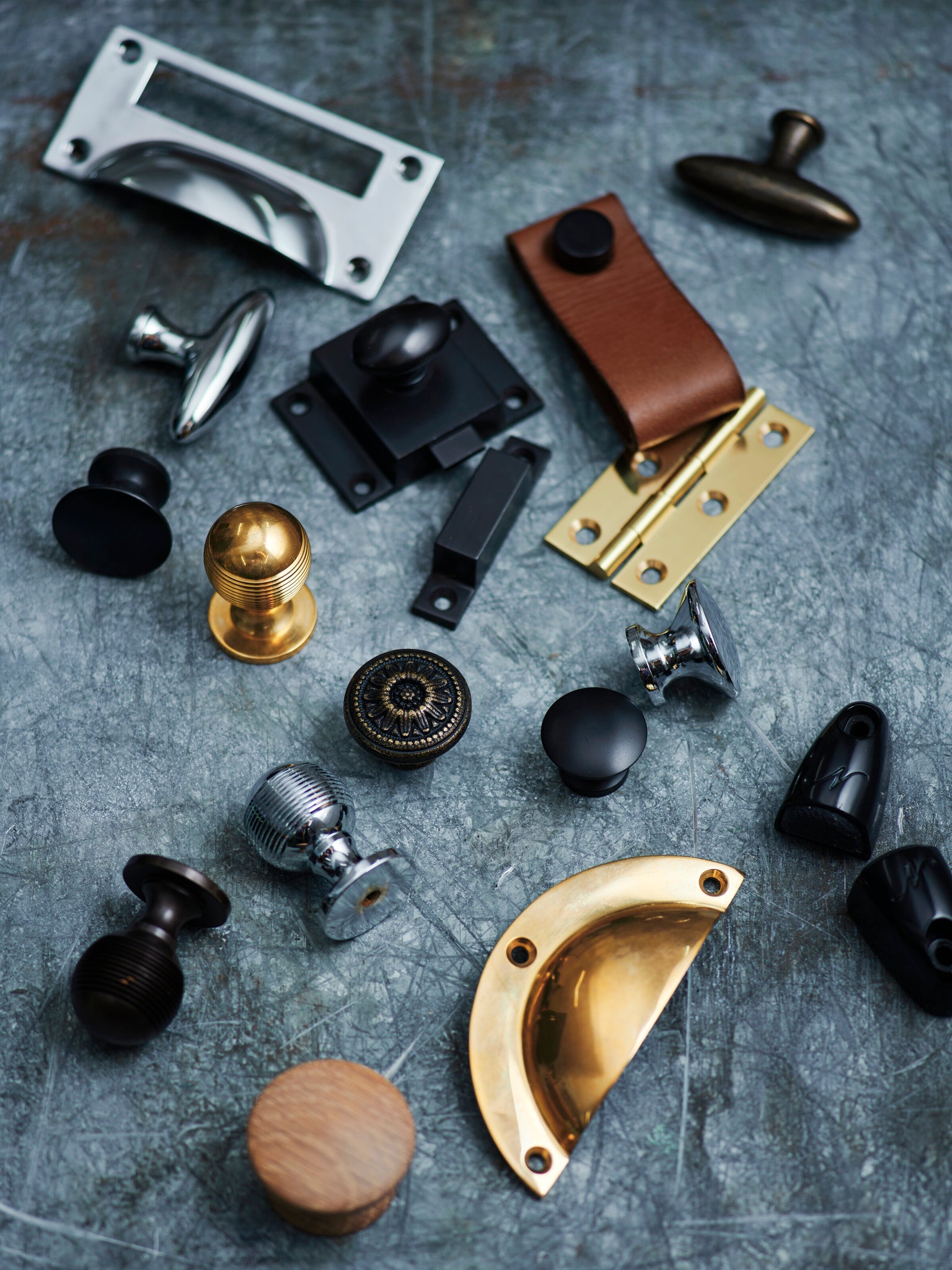From velvet and wool to an array of linens, when it comes to our fabrics, there’s something for everyone. But sometimes, settling on the right fabric for your new sofa, headboard or curtains can feel a little overwhelming. There’s a lot to consider � from its main function to the room it’ll belong in, and even the family members that’ll be using it (the fluffy, four-legged variety included). To simplify the decision process, our home designer Kyra explains the characteristics of � and best uses for � each of our weaves. (In a hurry? You’ll find a quick ‘at a glance� box at the end of each fabric category.)
Printed linen
Our printed linens offer a softer, simpler way to experiment with pattern � with just one background and one print colour to consider.
If you’re upholstering furniture, make sure the scales are similar. For example, Orla’s best for smaller pieces like our Milo stool; Francesca grand for larger pieces like our Charlie headboard; and Emma for medium-scale pieces (and particularly our Matilda armchair, although we have also experimented with it for sofas before). For curtains and blinds, Emma, Orla, or the smaller Francesca print are best on a full blind or as a curtain border, while the larger Francesca grand print is better for curtains for large windows.
If you have children or pets at home, we’d suggest choosing one of the designs with an unbleached base fabric for upholstery (that’s all the Emma and Orla colourways but not Francesca). Slightly darker than the bright white versions, they’ll be more forgiving when it comes to marks.
Printed linen at a glance
In this collection: Francesca, Emma, Orla
Best suited to: curtains and blinds, armchairs, footstools, dining chairs, bar stools, headboards, cushions
Use it in: sitting room, dining room, bedroom
Style: traditional, relaxed, country, formal (Francesca)
Lifestyle: adult-only, family, and pet homes
Woven linen
Our Samuel woven linen comes in two muted colourways and has a soft drape and irregular stripe for a relaxed feel. It’s a design that’s all about creating a subtle accent. Because of its widely spaced, irregular stripes, however, it’s really best suited to headboards, cushions, curtains and blinds, and plain footstool designs such as Eloise.
Samuel has a high rub count, which means it’s suitable for everyday use and will wear well over time.
Woven linen at a glance
In this collection: ³§²¹³¾³Ü±ð±ôÌý
Best suited to: curtains and blinds, headboards, footstools, cushions
Use it in: sitting room, dining room, bedroom, kitchen (as blinds)
Style: relaxed, country, coastal, traditional
Lifestyle: adult-only, family, and pet homes
Cotton linen (fine)
Our versatile cotton linens combine cotton’s elasticity, strength and softness with the subtle texture of linen. Linara has a soft, peach-skin feel and makes a good option for loose-covered upholstery, like our Long Island and Charlie sofas � as well as bench and seat cushions. Its draping qualities are also ideal for curtains and blinds.
Linara is machine washable if you choose a design with loose covers, but just know that the darker and richer colourways may fade. It’s also worth saying that, although thisÌýfabric isÌýmore than strong enough for family life, being so plain, it will show stains more easily.
Cotton linen (fine) at a glance
In this collection: Linara
Best suited to: curtains and blinds, sofas, armchairs, footstools, dining chairs, bar stools, headboards, cushions
Use it in: sitting room, dining room, study
Style: versatile
Lifestyle: adult-only, family and pet homes (loose covers are machine washable)
Washed linen (fine)
Imogen’s a delicate fabric that’s suited to light use, so it’s best to avoid using it to upholster sofas or dining chairs (it also has a slightly looser weave, so we wouldn’t necessarily recommend it for homes with cats). Made from 100% linen, it offers a laidback look in two subdued shades and will help to soften spaces.
Use Imogen for occasional furniture, such as our Alex footstool, on headboards, for cushions, or even for curtains with a more relaxed, rumpled look.
Washed linen (fine) at a glance
In this collection: Imogen
Best suited to: headboards, occasional chairs and stools, cushions, curtains and blinds
Use it in: bedroom, sitting room
Style: relaxed, laidback, coastal
Lifestyle: adult-only home
Original linen (heavy)
A great all-rounder, Hugo works in almost every room of the house. The thick, uniform weave tends to suit more traditional homes, and brings a lovely formality to upholstered pieces, but has the versatility to feel more relaxed as well, depending on the rest of the space. In a selection of understated colourways, it’s a timeless option too.
The 100% linen, thick weave also means it’s hardwearing and holds its shape well, so it looks especially great on sofas (our first choice would be Olivia) and armchairs. If you have pets that use your furniture though, we’d suggest going for a tighter weave (like Harry, Chloe or the fine cotton linens) as they could potentially get their claws into Hugo.
Original linen (heavy) at a glance
In this collection: Hugo
Best suited to: sofas, armchairs, dining chairs, bar stools, headboards, footstools
Use it in: bedroom, sitting room, dining room, study
Style: versatile
Lifestyle: adult-only and family homes
Performance linen
The most robust of our fabrics, Archie’s a reliable upholstery choice for busy family homes. The durability of this fabric makes it slightly firmer, so it’s best used for pieces in active daytime spaces, rather than cosy snugs, and we wouldn’t use it for cushions or window treatments.
A natural choice for sofas that are used daily, Archie’s also great for dining chairs and bar stools, and can handle much of what busy family life throws at it.
Ìý
Performance linen at a glance
In this collection: Archie
Best suited to: sofas and armchairs, footstools, dining chairs and bar stools
Use it in: playroom, sitting room, dining room
Style: versatile
Lifestyle: family and pet homes
Character linen (fine)
Our finer character linen, Harry, is a relaxed fabric with excellent drapability. Machine washable and with a stain repellent coating, it’s a safe choice for homes with children and pets too.
Use Harry on a loose cover sofa design such as Long Island for a laidback look, or if you prefer something more structured, on a headboard such as Charlie or Olivia. The natural slubs in the weave will bring texture and interest to these larger-scale designs. Harry’s flowing drape also makes it a favourite for curtains and blinds.
Character linen (fine) at a glance
In this collection: Harry
Best suited to: headboards, occasional chairs and stools, sofas, curtains and blinds, dining chairs
Use it in: bedroom, sitting room, dining room
Style: versatile
Lifestyle: adult-only, family and pet homes (stain repellant, and loose covers are machine washable)
Character linen (medium)
The thicker of our two character linens, Chloe’s an unstructured fabric by nature. The stonewashed finish gives it a very soft and supple quality, so it’s particularly complementary in spaces with a lived-in look and feel, and when used for long curtains.
Alternatively, if you want to achieve a slightly more structured look with Chloe, use it on fixed upholstery pieces, rather than designs with loose covers.
Ìý
Character linen (medium) at a glance
In this collection: Chloe
Best suited to: headboards, sofas, armchairs, footstools, dining chairs, bar stools, curtains
Use it in: bedroom, sitting room, dining room, snug
Style: relaxed, laidback, versatile
Lifestyle: adult-only, family and pet homes (loose covers are machine washable)
Velvet
The perfect statement fabric, use Isla wherever you want to create impact. Sofas and headboards are natural choices, while armchairs and footstools will allow you to introduce velvet on a slightly smaller scale.
Studs and velvet make for a perfect partnership, as do buttons, so our Eva, Shoreditch, Casper, Lottie, George and Charlotte collections upholstered in Isla are well worth considering. And while traditional laid velvets are prone to crushing, Isla’s multidirectional pile resists pressure marks, making it much better suited to everyday � and family � use too.
Even so, it is worth knowing that velvet will take on more character over time than linen, cotton or wool. For that reason, we wouldn’t suggest it for homes with pets that use the furniture, and also only in formal dining rooms as liquids will stain.
Ìý
Velvet at a glance
In this collection: Isla
Best suited to: headboards, sofas, armchairs, footstools, curtains
Use it in: bedroom, sitting room, snug
Style: contemporary or traditional, semi-formal Lifestyle: adult-only and family homes
Wool
Wool is a smart choice if you have a young family and pets as it’s naturally water resistant, incredibly hardwearing, and, with natural flecks in the yarns, less likely to show marks. Our wools are great for sofas and armchairs, dining chairs and bar stools, and offer another way to bring texture and pared-back pattern (if you so desire) into a room.
Choose from our plain wool, Angus, Elliott’s herringbone pattern (a lovely fit for a study), or Hector’s understated check. For a lighter, less traditional look, you can pair our wool fabrics with our linens, or to embrace cosiness, use alongside our Isla velvet.
Wool at a glance
In this collection: Hector, Elliot, Angus
Best suited to: sofas, armchairs, footstools, dining chairs, bar stools, headboards, winter window treatments
Use it in: bedroom, sitting room, snug, dining room, study
Style: traditional, more formal
Lifestyle: adult-only, family and pet homes
Harris Tweed
The most traditional of our fabrics, Harris Tweed is made to a very high standard in the Outer Hebrides.
As with all wools, it’s naturally water resistant, but it’s also been through an extra milling process to make it even stronger and more durable for upholstery too. In comparison to our regular wool collection, it has a slightly looser, thicker weave (so that is something to take note of if you have pets particularly prone to clawing).
The rich colour choices make Harris Tweed particularly great for armchairs and headboards in snugs and cosy bedrooms.
Harris Tweed at a glance
In this collection: Harris Tweed
Best suited to: headboards, sofas, armchairs, footstools
Use it in: bedroom, sitting room, snug, study
Style: traditional, formal
Lifestyle: adult-only, family and pet homes
Leather
Although leather doesn’t fall within our fabric collection, it’s another great option for some of our upholstered pieces, so we’ve included Barnaby in the list.
Like velvet, a high-quality leather like this will develop character over time. It’s why we think it’s best for smaller designs like occasional armchairs or footstools, rather than whole sofas (although, as you’d expect, it does suit our Chesterfield-style Lottie sofa), where it’ll bring another texture and dimension to your space. You can absolutely use it in a home with children or pets if you’re happy to embrace marks and scuffs as a natural part of ageing leather.
Our leather colourway, Saddle, is a classic tan shade. You could incorporate it into a more contemporary space, but we do think it has a classic feel to it.
Ìý
Leather at a glance
In this collection: Barnaby
Best suited to: occasional chairs, Lottie, footstools, dining chairs
Use it in: sitting room, snug, study, dining room
Style: traditional
Lifestyle: adult-only home
Explore the fabric library here, or order your free swatches. It’s worth noting that our Archie performance linen and Barnaby leather aren’t available by the metre.
]]>







































